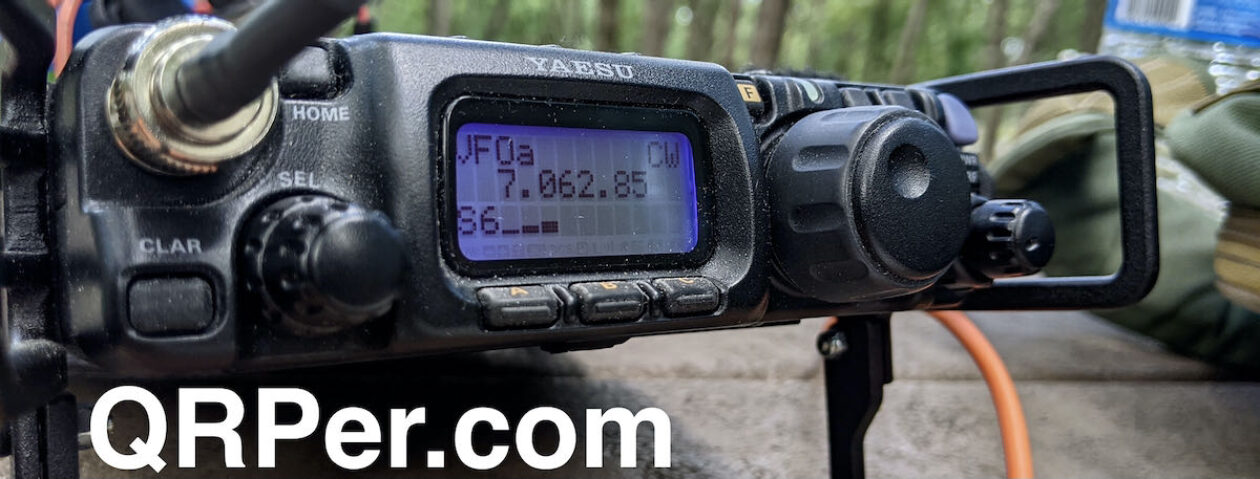 Many thanks to Scott (KA9P) who writes:
Many thanks to Scott (KA9P) who writes:
Enclosed are a few detailed pictures of the system I’m using to protect my Icom IC-705 in the wild.
I wanted a system that would protect the radio from shock and vibration when I dropped it in use, or tripped over a cable, as well as when in transit.
Some research lead me to Sorbothane, a commercial vibration damping material available in small lots on eBay, and to a Sorbothane applications engineer. The engineer recommended that a good way to protect electronics is to use a “box-in-a-box” concept where the equipment resides in an inner box with vibration dampers between the inner box an outer box.
Sorbothane’s on-line calculators suggested that for the IC-705’s weight, some relatively small pads on each wall would be adequate.
So I started with the bottom 4.5 inches of a Harbor Freight ammo box, and added four 1/4 inch thick, 1 inch by 1 inch Sorbothane pads to the bottom and two long sides.
Then I added an aluminum plate to the inside side surfaces of the pads, and lined the plates with neoprene (see the drawing above). The neoprene adds a bit of additional padding, but primarily lets the 705 slide into “the inner box” while putting a little bit of pressure on the pads. The manufacturer recommends a slight loading pressure on the pads for proper damping.
The radio is fastened into the box with an adjustable depth 1/4-20 threaded locking knob, positioned to put a little force on the back wall vibration pads when tightened down.
The cover is made of aluminum angle stock and Lexan, and provides good protection for the front of the radio when not in use.
This “shock box” solves a lot of problems for me.
1) I can leave the cage on when operating, using dongles out the front for things I want to change like the antenna, mic, battery power, headphones or paddles. Leaving the radio in the box avoids field handling errors, to which I am prone.
2) If the internal battery needs to be changed in the field the radio comes out quickly by removing the single 1/4-20 knob and screw. But the battery can be charged in the case with a USB or power plug dongle, again avoiding handling.
3) The depth of the box protects the entire periphery of the radio front, much like the handles do for the sides of a cage, and the radio remains enclosed/covered on all sides except the front. I’ve used it in snow and rain without issues when the wind isn’t bad.
4) Impact protection is really high other than for a direct frontal panel hit within the box. The plastic box takes the first hit, deforming a bit and transferring the rest of the energy to the vibration damped inner box. Not worried about dropping the radio anymore.
5) The use of Sorbothane’s “box-in-a box” with vibration pads concept leaves a channel surrounding the radio to promote air flow and heat dissipation. For me this is much better than using the radio in a box cushioned with foam, which blocks air flow and can trap moisture.
6) The box provides a handle, which the 705 really does need in the field.
7) The footprint of the Harbor Freight box is just about a hand and glove fit in the bottom of most serious packs, making it easy to carry when backpacking.
On the downside, it’s a bit ugly, but it’s cheap, maybe $40 US to build. Other than wanting a gasket to provide better weather and dust proofing when closed, I’m happy with it.
-Scott (KA9P)
A bit ugly? Scott, I think it looks great!
I feel like shock absorption is one of the things lacking in many of the IC-705 cage solutions out there. I always feel like when a metal/aluminum frame is paired with a hard plastic chassis, in a field drop the plastic will be the weak point.
This adds to the bulk of the IC-705 (in terms of overall size) but likely doesn’t add a lot of extra weight. In your manpack/chest pack situation, this is a great bit of engineered insurance for your $1300+ rig!
Thank you for sharing!























